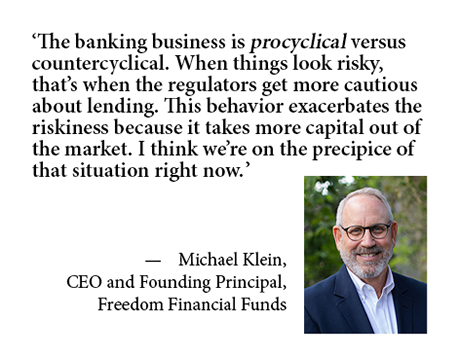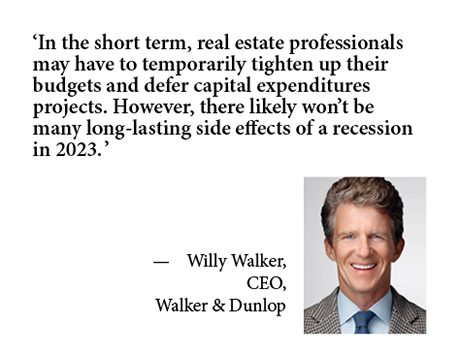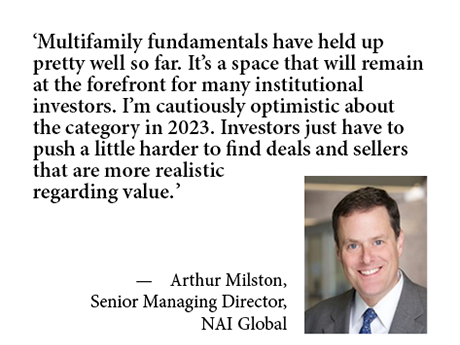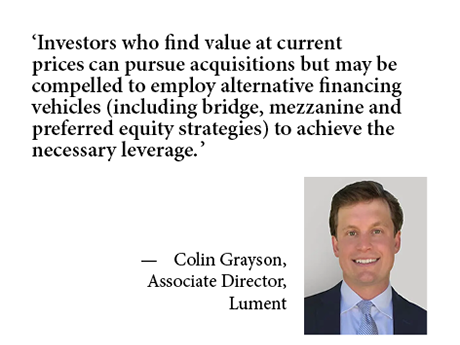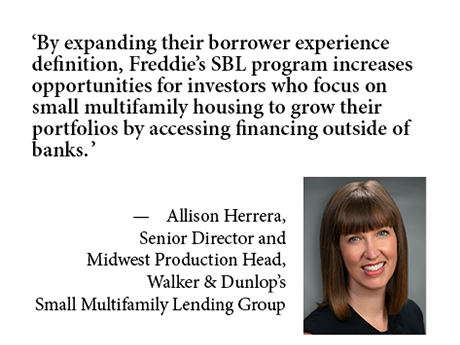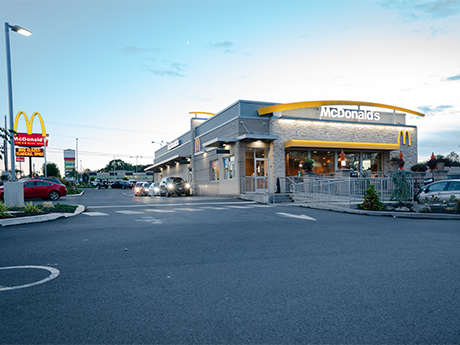Prospective investors can finance acquisitions even when equity is scarce, explains Michael Klein, CEO and founding principal of Freedom Financial Funds. “The scarcity of equity is an old phenomenon; it’s a relatively new phenomenon that made equity plentiful. For most of history, it was hard work to find equity. However, even in a tight market, if there’s a compelling case for a project to result in success and there are multiple ways of protecting the equity and the debt, that deal will get done.” This is the outlook Klein brings to the 2023 MBA Commercial/Multifamily Finance Convention & Expo. Klein’s company, Freedom Financial Funds, LLC is a private REIT based in Los Angeles and operating in the western United States. The REIT specializes in providing capital to real estate professionals adding value to projects. Debt, Equity and Protecting Value Klein explains that with any type of financing, whether it be debt or equity, it is key to have a compelling story and facts to indicate that the borrower is going to provide a fair amount of value. “Protecting the investor from potential downside risks is an essential part of financing,” explains Klein. This sort of forethought requires thorough due diligence …
Content Partner
By Willy Walker, CEO of Walker & Dunlop Fed’s Recent Mistakes In a recent Walker Webcast, “Most Insightful Hour in CRE with Dr. Peter Linneman” part of our ongoing webinar series, renowned economist Dr. Linneman and I discussed his views on monetary policy, inflation and what the economic and commercial real estate landscape looks like for 2023. Throughout the past year, the Federal Reserve has been raising the federal funds rate faster than we have ever seen. This, of course, has led to a drastic increase in the cost of borrowing, the likes of which haven’t been seen in decades. In just one year, the effective federal funds rate has increased from 0.08 percent in February 2022, all the way to a target range of 4.5 to 4.75 percent in February 2023. This has led many to believe that the Fed has considerably overshot where rates should be since the market wasn’t given ample time to react to each rate hike. This rapid increase in interest rates has reduced lending activity in terms of new loans, leading to a sharp decline in demand for real estate, as well as major price corrections. Additionally, the rapid rise in borrowing costs has …
Data Center Developers Consider Unconventional Sites, Streamlining Strategies to Meet Immense Demand
Data center development is simultaneously growing by leaps and bounds as well as suffering from its own success. The easy-to-develop sites have been snapped up and demand for additional data and cloud services continues to grow, forcing developers to look beyond the obvious locations for sites. This can entail running into less-than-obvious delays in the development process. Data centers reliably store and transmit the deluge of information that makes modern life possible. The factors driving the need for data centers — enterprise demand for cloud services, dependence on 5G cell networks, artificial intelligence technology, edge computing capabilities, social media use and streaming needs — will continue to grow exponentially in the coming years. According to a September 2022 report by advisory company Arizton, approximately 2,825 megawatts of power capacity will be added to the data center market in the next five years. The same report forecasts the U.S. data center construction market will reach $25 billion by 2027, up from $20 billion in 2021. Data centers are utility-intensive property types, and the sites that can support their formidable power, communication and water needs often require high-level considerations right from the start. How can the development process for such projects be streamlined …
The mere flipping of the calendar to mark a new year has done nothing to inject certainty into the next 12 months. The higher cost of credit that muted commercial real estate investment sales in the second half of 2022 and the attitude of some sellers who refuse to recognize the new pricing reality remain in place in the new year. Many eyes are on the Federal Reserve, hoping for a respite in interest rate hikes after the central bank raised the effective benchmark federal funds rate some 400 basis points to 4.33 percent in less than a year, according to the Federal Reserve Bank of New York. Some investors are even hoping for a rate cut. Neither of those is likely, at least in the short term, observes Arthur Milston, a senior managing director of NAI Global in New York City. While inflation has cooled to an annual rate of 6.5 percent from a high of 9.1 percent in June, that’s still far off from the roughly 2 percent annual target that the Fed desires, he adds. That should translate into continued tightening, Milston says, although the question is, how long will the central bank keep raising rates, and …
Against the backdrop of higher interest rates and the collapse of commercial real estate investment transactions, large brokerages have begun to reduce staff and other expenses to weather growing uncertainty over property values. But executives at Lee & Associates Commercial Real Estate Services consider it an ideal environment to continue an expansion that has added more than ten new locations over the last few years. Earlier this month, Lee & Associates announced the opening of an office in Baton Rouge, La. In November, they opened an office in Calgary, Alberta. In the same month, a satellite office in Nashville, Tenn. transitioned to a freestanding office, a designation that provides brokers in the office with the opportunity to fully benefit from the Lee & Associates capital structure — namely, to participate in funding the brokerage’s future growth and reaping the potential rewards. Those additions followed new office expansions in downtown Los Angeles, San Francisco and Omaha, Neb., earlier in the year. The Southern California-based brokerage anticipates announcing two more openings in early 2023, eventually increasing its footprint to around 90 locations from more than 70 today, says Jeffrey Rinkov, CEO of Lee & Associates. “We see some of our competitors cutting …
By Colin Grayson, Lument If you consider multifamily real estate assets to be a good investment, you are in good company. At mid-year, asset managers and private equity firms alone held an estimated $325 billion of levered dry powder set aside for this purpose, enough cash to finance nearly every acquisition closed in the United States in 2021, the highest investment sales volume on record. Despite nearly unanimous support for the asset class, however, multifamily transaction volume in the third quarter slumped year-over-year for the first time since the peak of the pandemic. The mainspring was a sharp rise in mortgage financing costs triggered by high inflation and the Federal Reserve’s commitment to raising rates to bring it under control. Generic rates for 65 percent loan-to-value (LTV) first mortgage debt stood on 5.71 percent at the end of November, representing an increase of 248 basis points since the beginning of the year. Even as financing costs soared, asset pricing changed very little. Initial net cash flow yields of transactions closed in the third quarter of 2022 averaged only 4.6 percent, according to Real Capital Analytics, an increase of 10 basis points from second-quarter 2022 levels. At the same time, cap …
AcquisitionsArbor Realty TrustBuild-to-RentContent PartnerFeaturesMidwestMultifamilyNortheastSingle-Family RentalSoutheastTexasWestern
Investors Drawn to Single-Family Rentals During Tough Economic Times
By John Tarantino, Arbor Realty Trust The ongoing expansion of the single-family rental (SFR) market is capturing investors’ interest like never before. Construction starts in the sector topped a record 69,000 units over the past year, while the rate of rent growth remained positive for new leases and accelerated in renewals. That’s according to the third-quarter Single-Family Investment Trends Report Q3 2022, which Arbor Realty Trust recently published in partnership with Chandan Economics. SFR investors want to know what this latest market data reveals about how the sector is weathering economic changes and what it suggests about how their properties are likely to perform in the months ahead. In December, I was privileged to weigh in on these weighty questions as a panelist at Information Management Network’s 10th Annual Single-Family Rental Forum (West) in Scottsdale, Ariz. One of the messages I sought to convey to the audience that day is that single-family rentals have maintained their momentum as well as any corner of the housing market, as our third-quarter report bears out. And while rising interest rates and elevated risk have placed the housing market on shaky ground, SFR is on a secure foundation moving into 2023. With the average age …
By Allison Herrera, Walker & Dunlop Effective Dec. 15, 2022, Freddie Mac began accepting ownership of two- to four-unit properties — aka duplexes, triplexes or quadplexes — as relevant experience for all loans in its Optigo® Small Balance Loans (SBL) program. Previously, Freddie Mac defined multifamily experience as controlling ownership of a property with at least five units or more and excluded two- to four-unit properties. By expanding its borrower experience definition, Freddie’s SBL program increases opportunities for investors who focus on small multifamily housing to grow their portfolios by accessing financing outside of banks. What Qualifies as Experience? Here’s what you should know. Freddie Mac expanded their definition of multifamily experience to include borrowers who have a portfolio of two- to four-unit properties that meet the following criteria: The borrower must own at least 10 units total The borrower must have owned each property for at least two years The borrower must have a controlling interest in all 10 units The 10 units do not need to be contiguous or located in the same county The new requirements provide investors access to agency debt when beginning to invest in larger properties, such as those with five to 50 units, …
For a little more than a year now, Americans have gone on a collective road trip, making up for time stolen during the lockdowns. In turn, that has fueled a rebound in the hotel industry, which was decimated in 2020 and much of 2021. Revenue per available room (RevPAR), a key measure of hotel profitability, is expected to end 2022 at an average of $93, up nearly 8 percent versus 2019, according to a hotel forecast update in late November by STR, a hospitality research organization based in Hendersonville, Kentucky. Meanwhile, the projected average occupancy of 62.7 percent will mark an increase of 5.1 percentage points over 2021, and the estimated average daily rate (ADR) of $148 will best last year’s number by $23, STR reports. Select service lodging properties in particular are helping to lead the recovery, says Steven J. Martens, chairman of NAI Martens, a Wichita-based commercial real estate brokerage that is one of five brands under the Martens Companies umbrella. “The majority of the midscale and upper midscale assets are very dependent upon leisure travel, and they are seeing a rebound throughout the country,” he adds. “Most good operators with strong hotel brands have seen very healthy …
BohlerContent PartnerDevelopmentFeaturesIndustrialMidwestMultifamilyNortheastOfficeRetailSoutheastTexasWestern
Retail Development Program Lessons Apply Across Property Types
Retail development programs have allowed retailers to streamline their goals by creating prototype models based on site particulars. This process saves developers and retailers money as they can be flexible in choosing models that work for each site without needing to alter layouts and features too much between builds. But what makes for successful prototypes and program standards? Can this approach work outside of the retail world? “The lessons of retail programs can apply across property types in this sense: land development consultants and site designers can learn how specific clients need their set of standards and guidelines implemented. It’s essential to thoroughly understand a program client’s procedures, and we’re expected to know these parameters inside and out,” says Steven T. Fortunato, a senior project manager at Bohler’s Rehoboth Beach office in Delaware. Bohler is a land development design and consulting firm that specializes in helping developers move their projects forward faster. “The retail program methodology translates well to other sectors. Starting off with either a new developer or a new client is an opportunity to learn their standards — or help the client create them. The end result must offer the same level of confidence whether the product is retail or …


